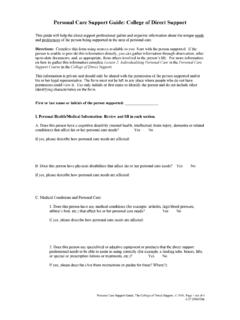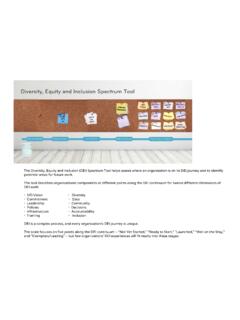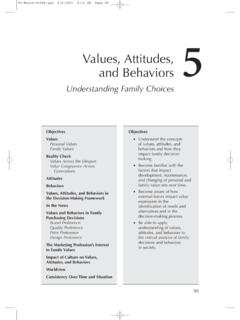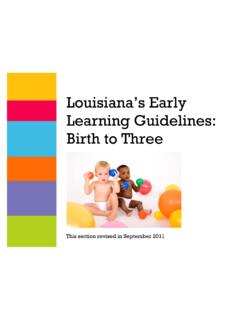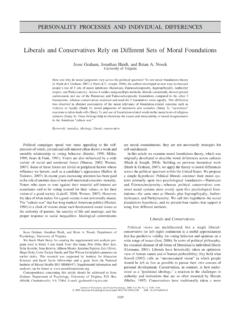Transcription of The Cultural Competence Continuum
1 The Cultural Competence ContinuumAfter completing this lesson you will be able to: Describe the importance of being able to assess levels of Cultural Competence . Describe the six points on the Cultural Competence Continuum . Place examples of organizational practices, media, service practices, or social norms on the Cultural Continuum . Identify where you are functioning on the Cultural Competence Continuum . Identify at least three methods for increasing your Cultural Competence . 2004 College of Direct Support Cultural Competence Lesson 4 page 1 of 9 The Importance of Assessment: Using the Cultural Competence ContinuumBeing able to recognize your own levels of Cultural Competence will help you continue your growth in Cultural Competence .
2 Knowing your strengths will help you build on them. Knowing where you need to learn more will guide you in finding about what you have already learned from the other lessons in this course, from other formal or informal training and education, and from your life experiences. Using what you know and have learned, answer the following ) Write a definition of Cultural Competence . Include in your definition the five elements learned in a previous lesson. Use your own words. 2) Describe the different stages of Cultural Competence (the Continuum ). Use your own words. 2004 College of Direct Support Cultural Competence Lesson 4 page 2 of 9 Understanding the Six StagesCultural Destructiveness and Cultural IncapacityPeople and organizations in the stages of Cultural Destructiveness and Cultural Incapacity: Do not value diversity.
3 They may feel that people who are different from them are abnormal, weird, or dangerous. Do not recognize culture. They see Cultural differences as expressions of right and wrong. Do not desire to learn more about other cultures. They may become angry if asked to take part in discussions or activities related to diversity awareness. Will resist changing their behavior to meet the needs of others. They may become very angry if changes happen around them. They may passively resist changes. They may intimidate others. They may make things difficult for is Cultural Destructiveness?People and organizations who demonstrate Cultural destructiveness will actively try to harm others. They believe they are superior to others.
4 They may disregard the rights of others. Around the world and through the ages there have been crimes committed that have Cultural destructiveness at their roots. In some cases, these crimes are large and affect many. At other times, they are directed towards individuals and carried out by individuals or small groups. Unfortunately, these types of crimes are not uncommon. What is Cultural Incapacity?People and organizations/employers who demonstrate Cultural incapacity have little understanding about their own prejudices. They believe false and unkind information about others. The following are the types of stereotypes that people who demonstrate Cultural incapacity might believe: Gay men are child molesters.
5 African-Americans are less intelligent than European-Americans. Women are not as good as men at math and science. American Indians drink too much. Women on welfare have babies to avoid working. Muslims are terrorists. Jews are rich. People with developmental disabilities are dangerous. A Korean neighbor will eat your pet dog. Homeless people are drug abusers or lazy. 2004 College of Direct Support Cultural Competence Lesson 4 page 3 of 9 Review the information about Cultural incapacity and reflect on any stereotypes that you might, or did have, or that others you know have, or did have. Make any notes or comments that you wish to InattentionPeople and organizations in the stages of Cultural Inattention: Value diversity, but only superficially.
6 They may enjoy trying new food. They may like learning about new customs. But they do not understand less obvious Cultural differences. See culture as a surface feature. They see Cultural differences as choices or preferences and not uniqueness. Some examples include choosing how to dress or which church to attend. They do not understand the hidden aspects of culture. They are uncomfortable with the thought of differences in values and core beliefs. Desire to learn more about other cultures but resist or do not understand some important information. They may become angry if others suggest that there may be true fundamental differences in values among cultures. Will resist changing their behavior to meet the needs of others when the behavior reflects a deeper value choice.
7 For example, they might serve different food at a meeting, but may not rearrange the timing or format of the is Cultural Inattention?Organizations or employers who do initial diversity training without on-going assessment and learning may find themselves at the stage of Cultural Inattention. People and organizations at this stage are usually enthusiastic about their first exposure to other cultures. They have grasped the easiest parts of the culture. But they can get off track when the barriers are more subtle. Without further training, support, or resources, they may fall back to Cultural to the voice clip to hear a woman talk about her experience at a diversity training on screen 13 on Lesson 4 and complete the questions ) Was this woman trying to be respectful?
8 Why, or why not? 2004 College of Direct Support Cultural Competence Lesson 4 page 4 of 92) What aspects of culture did this woman understand? What aspects of culture did this woman not understand?3) Do you think that it was appropriate for the service provider to adopt certain aspects of the target culture (for example, sage burning)? Why, or why not?4) What could have been done better in this situation? You learned about public policy, regulation, and best practices in the last lesson. You learned that these types of practices and policies often stem from the values and beliefs of the dominant culture of the United States.
9 Below is a direct public policy quote from a state human services agency. Read this statement and answer the questions below. Public Policy Statement: Self-reliance, consumer satisfaction and quality assurance inform the design and operation of consumer directed services. A seminal principal of the disability civil rights movement is that nothing should be done to foster dependence since independence and self-reliance are vital components of human dignity. (Italics and underlining added*)1) Do you believe that independence and self-reliance are vital components of human dignity? Why or why not? 2004 College of Direct Support Cultural Competence Lesson 4 page 5 of 92) Do you think this policy reflects Cultural Inattention?
10 Why or why not? If not, in what stage would you place it? Why?3) A primary focus of many cultures is to foster harmony and interdependence among family members into adulthood. As a service provider, give an example of how you would try to balance the intent of this public policy with the needs of individuals from these cultures. Cultural Pre-CompetencePeople and organizations or employers functioning at the stage of Cultural Pre- Competence : Value diversity. They understand that people like to eat different foods. They understand that people dress differently. They are beginning to understand some of the deeper Cultural differences. See culture as important. However, they find it difficult to understand.



